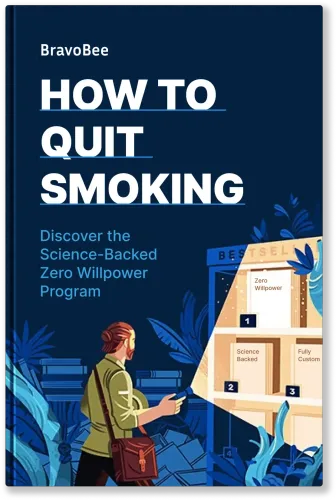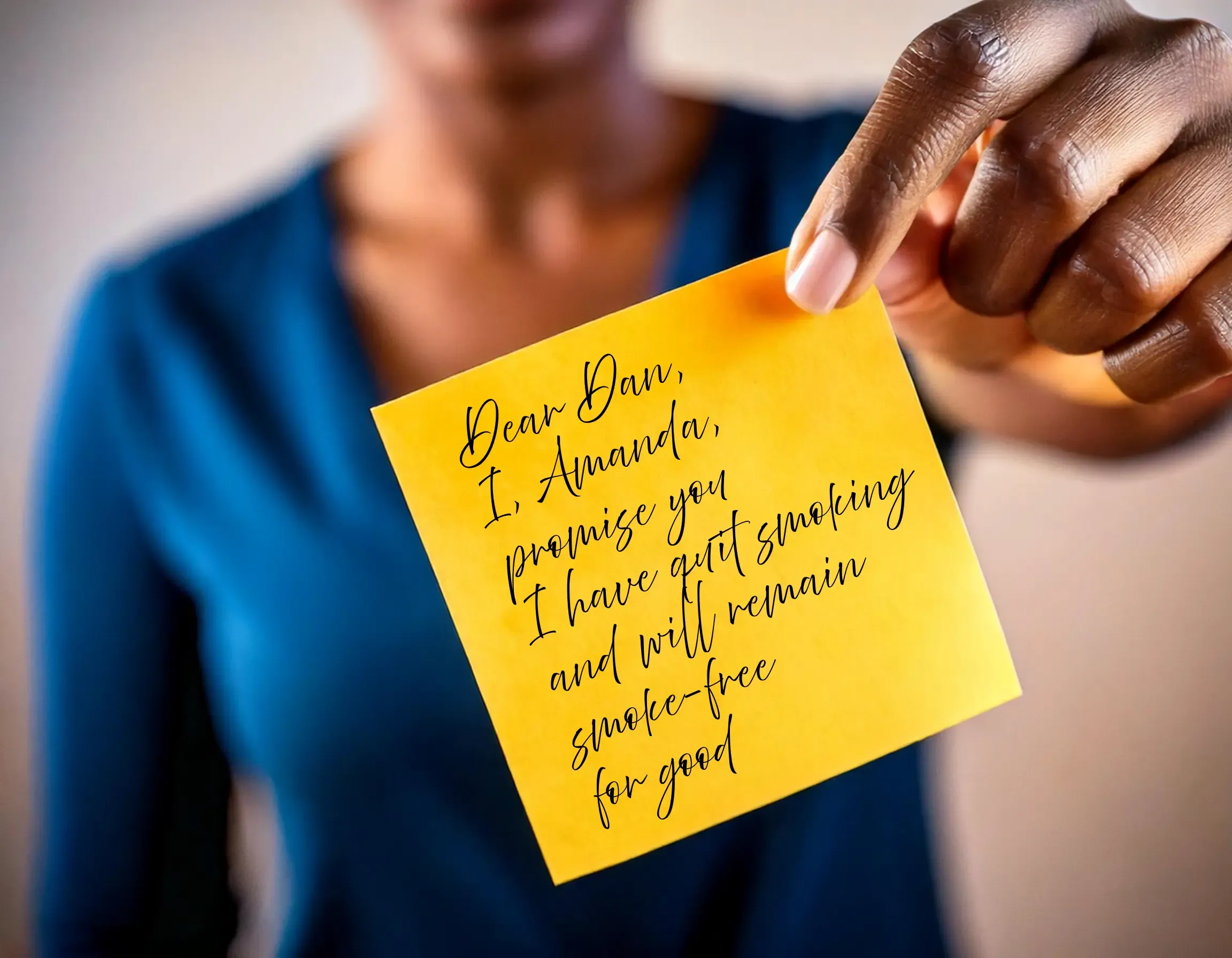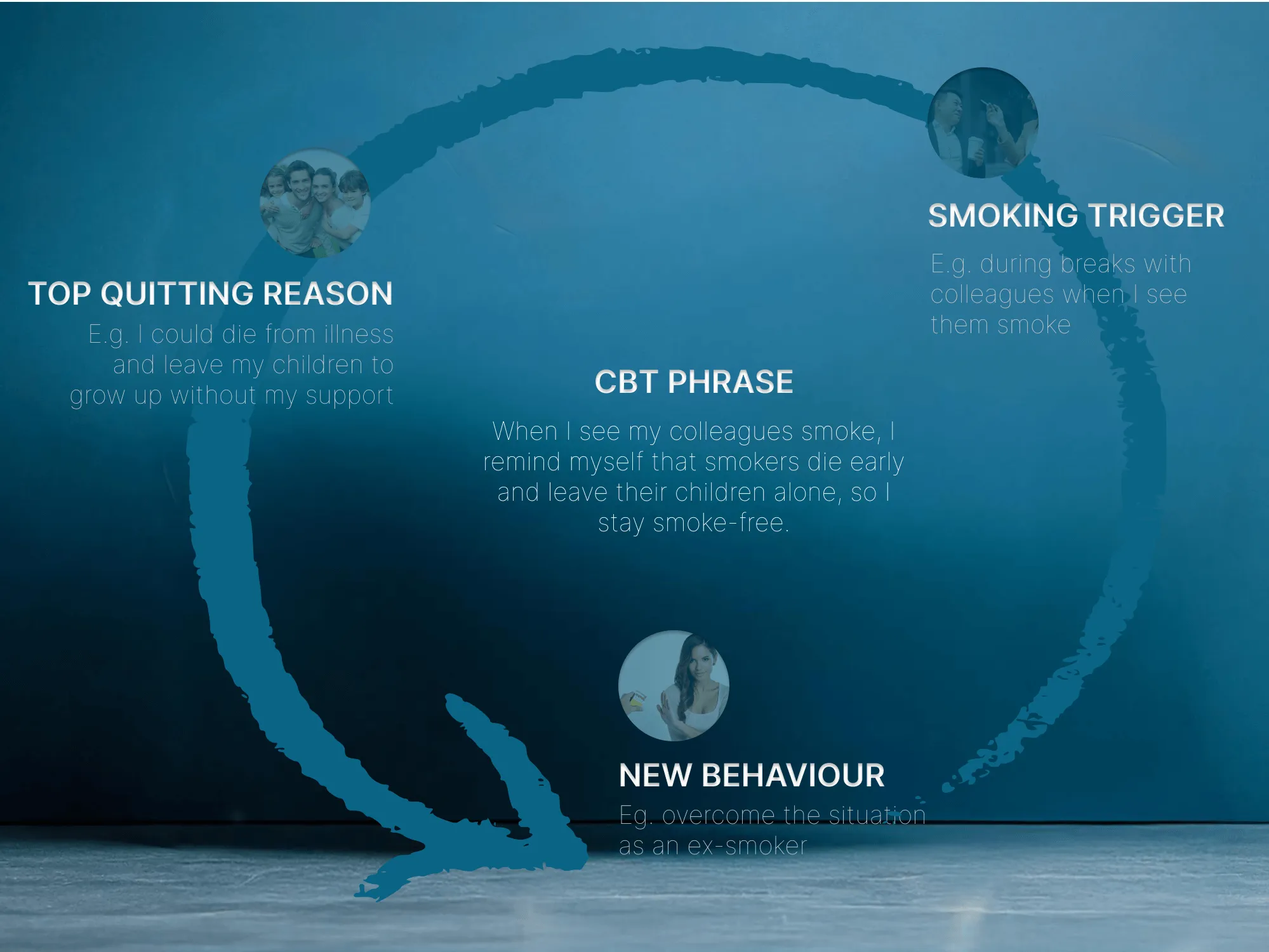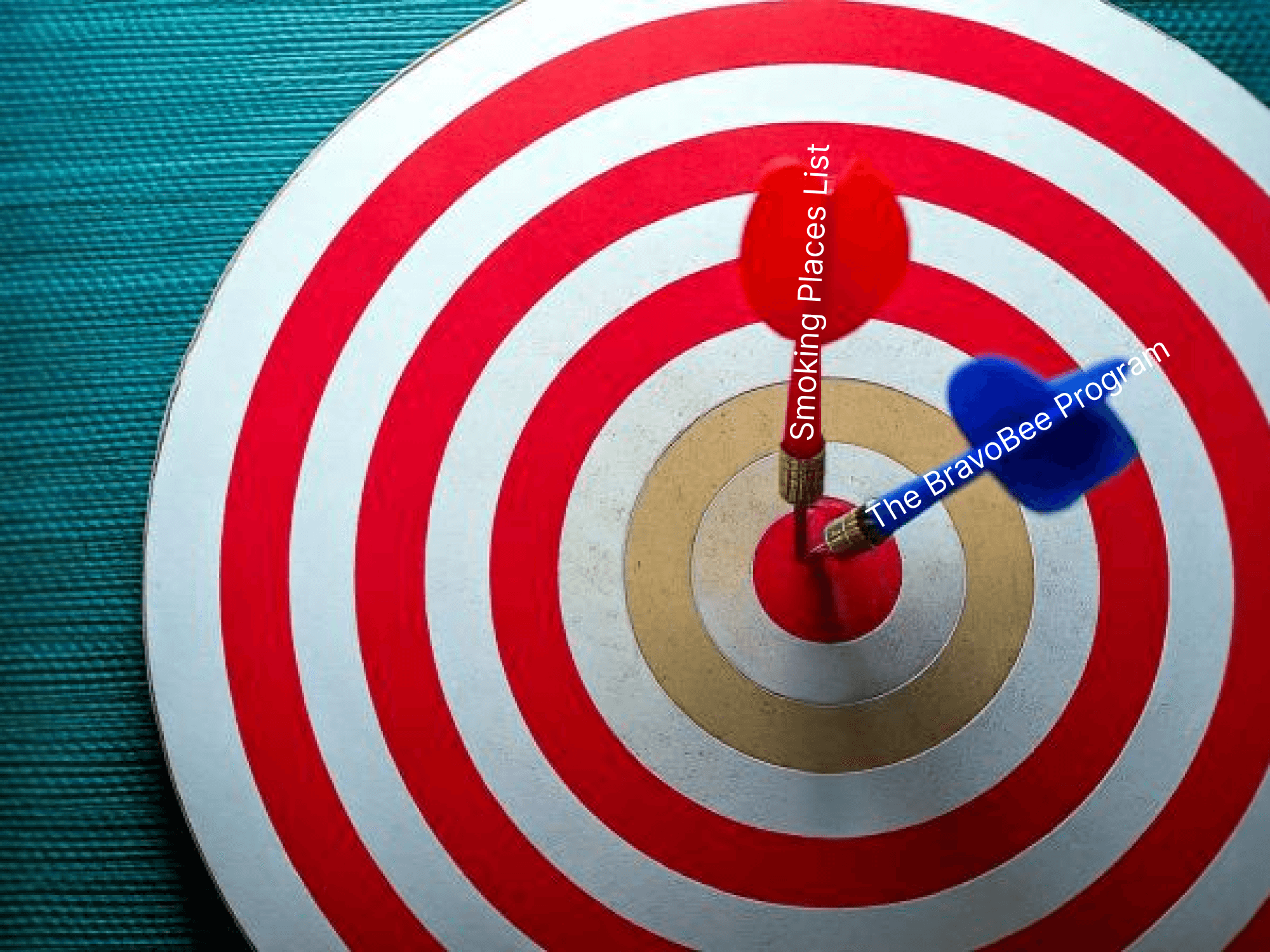The Quick How-to Quit Smoking Book: The Science-Backed Program That Works
Discover the science-backed quit smoking program that's guaranteed to work even for the heaviest smokers. Read the 4-step how to quit smoking book below.
Daniel Stefan
Apr 14, 2025
12 min read

Why this quick how-to quit smoking book?
If you've battled to stop smoking despite countless attempts, trust me, I've been there too. I picked up the habit in high school and fought for over a decade to shake it off.
My addiction was so overpowering that I couldn't even sleep through the night without waking up to light another cigarette. But then, in 2013, during one of those relentless cravings, I made a bold decision to focus all my energy into finding a real solution.
The very next day, while immersed in my work as an independent marketing consultant, an idea struck me like a lightning bolt. What if the marketing and persuasion tactics that get us persuaded to use different products in the first place could also be harnessed to free us from smoking for good?
Curious to learn more? You can dive into my full story of quitting smoking, but this how to quit smoking book is your passport to freedom. I stand as living proof that with the right strategy, even the most die-hard smoker can quit for good.
Inside this concise and easy-to-follow book, you'll discover the straightforward tools and methods you need to quit smoking forever:
Step 1: Overcome the Ostrich Effect Method
Step 2: Tap into Your Secret Support Group
Step 3: Use The Custom CBT Method
Step 4: Reward Yourself for Doing the Program
Optional Step: The Smoking Places List
Step 1: Overcome the Ostrich Effect Method
Ever find yourself dodging those cautionary tales, skipping over the chilling videos, or steering clear of any chat about the aftermath of smoking? Nearly every smoker or ex-smoker (myself included) has been there. We duck our heads like ostriches, thinking if we ignore the danger, maybe it won’t pounce on us.

This kind of avoidance is so common that it even has a name in behavioral economics. In 2009, a study dubbed it the “Ostrich Effect”(1). They discovered that investors frequently checked their portfolios when the market was booming but completely ignored them during downturns. Why? To shield themselves from uncomfortable emotions.
But let's be honest: if there's a lioness lurking, burying your head in the sand doesn't save you—it just makes you an easier target. Smokers do the same when they shy away from the harsh realities of smoking's impact on the body and mind. It might offer a momentary sense of relief—but at a deadly long-term cost.
Breaking free from the Ostrich Effect is simpler than you think. All you need is YouTube, and a sheet of paper. Every day, dedicate yourself to watching three videos that unveil the real-life repercussions of smoking. Personal stories work wonders—they slice through denial and bring the reality home.
Scientifically proven to work, this method is your ticket to doubling your success rate! Just look at the compelling results from the “Video-Based Smoking Cessation for Expectant Fathers”(2) study. The group that watched the videos achieved an impressive 22.5% abstinence rate after 6 months, leaving the control group’s mere 9.2% far behind. Basically, your success rate is doubled by adding this method to the quit smoking program.
To get you started, I’ve selected some compelling videos on the true cost of smoking. Just hit play. You’ll be surprised at how swiftly your mindset shifts when you stop hiding from reality—and begin confronting it head-on.
Step 2: Tap into Your Secret Support Group
Little do people realize that they have their very own secret quit smoking support group waiting to be activated—and so do you. But why would you even need that? After all, you're strong enough on your own, right? Or are you? Science, as highlighted in lots of studies (3,4,5) clearly demonstrates that tapping into a support group can skyrocket your chances of success by up to a mind-boggling 196%.
So, let's assume you're a fair-minded person and boosting your odds of quitting smoking by a staggering 196% sounds appealing—but you're not aware of any nearby support group, say in Florida, LA, or wherever you call home right now.
Here's the exciting part: your family, friends, and even colleagues are more than willing to become your secret support group and help you break free from addiction. All you need to do is grab a pen and paper, jot down the names of people who could form your secret quit smoking support group, and kindly ask for their support. It's recommended to include non-smokers or those who have already quit in your circle.
Each day, send a Post-it or a WhatsApp message to 1–2 members of your group, sincerely promising them that you HAVE quit smoking and intend to STAY smoke-free. To keep things running smoothly, try rotating through your support group—aim for messaging the same person every 3–4 days. Tracking this process is important.

It might sound a bit unusual at first, but believe me—handing out Post-its like “Dear Brandon, I Daniel, promise you I quit smoking for good” at work can turn out to be more enjoyable than you think. I remember colleagues quizzing me, “Hey man, you’re still on the right track, right?”
While you can dive deeper into this quit smoking support group topic, it's best to first read the entire How to quit smoking book to get a comprehensive overview of the BravoBee quit smoking program structure.
Step 3: Use The Custom CBT Method
The next powerhouse tool in your quit-smoking arsenal is a personalized CBT (cognitive behavioral therapy) method. There are plenty of CBT-inspired methods floating around, like The CBQ Quit Smoking Method, but back when I was fighting my own smoking battle, none were within reach.
Essentially, you'll need to create several CBT quit smoking phrases that you'll jot down daily. Over time, they'll become second nature—and you'll kick the habit. Plus, they'll serve as a lifelong guide to keep you smoke-free.
Science unveils that when CBT is combined with motivational interviewing, the average smoking cessation rate soars to an astonishing 61.8%. In contrast, using only CBT yields a 47.7% success rate (6). To put things into perspective, the usual cessation rate is around 3-5%. Merging your top reason to quit with personalized CBT strategies dramatically enhances your chances of breaking the smoking habit for good.
Here's how to craft your CBT quit smoking phrases in four steps:
- Pinpoint your smoking triggers (e.g., driving, hanging out with colleagues, parties, etc.).
- Identify your top reason for quitting smoking (e.g., avoiding cancer, living a longer life, your well-being, not depriving your loved ones of your presence by leaving too soon).
- Reframe smoking negatively based on your top cessation reason (e.g., smoking = leaving your kids to grow up without you being there for them).
- Create your custom CBT phrase by combining everything using this formula: when [trigger] -> I immediately remind myself that [negative association] -> and [new behavior].

Example: When my colleagues light up during the break, I immediately remind myself that smoking means leaving my children to grow up alone without me, so I successfully overcome the moment as an ex-smoker.
Craft your own CBT phrases today and watch the magic unfold. Fill up half a letter-sized page with them every day—trust me, this will work wonders for you too!
Step 4: Reward Yourself for Doing the Program
The BravoBee quit smoking program was designed to operate on Zero Willpower, gradually building momentum over a few weeks to months. Instead of the usual pat on the back for cutting down on cigarettes or quitting entirely, I chose a daring, unconventional path—I decided to reward myself for each day I simply followed the program.
And what's the most efficient way of rewarding yourself? By using a dynamic mix of reinforcement schedules paired with a token economy. Now, don't worry, you don't need to be a behaviorism enthusiast like B.F. Skinner to make this work. Just stick to these easy to follow steps:
- First, set a maximum reward amount that's just right—not too high, so you stay hungry for success, and not too low, so your enthusiasm doesn't wane.
- Next, create a wish board—a visual gallery of things you dream of buying, all aligned with your daily max reward. Load it up with items that excite you.
- Then, as you follow the program, mark each successful day by using a random number generator to determine a reward between 0 and your max daily limit. Get creative—I used a notebook with pages designed like bank checks to log my daily earnings.
- Once you've accumulated enough, you can trade your earnings for goodies from your wish board. The secret is in the process: follow the program, earn random rewards, track your progress, and cash in for wish board items.
Remember, the magic lies in adhering to the program, which will naturally guide you to quit smoking for good. The reward system serves one purpose—to keep you on track until momentum takes over and the habit breaks. Trust me, this approach is a game-changer.
Optional Step: The Smoking Places List
Quitting smoking isn't one-size-fits-all, and what many don't realize is that for heavy smokers—those burning through 20+ cigarettes daily—there's a scientifically validated alternative that's better than the cold turkey approach. When withdrawal cravings feel unbearable, remember I've been in your shoes, and it's precisely why the Smoking Places gradual reduction method was a game-changer when I quit.
Research specifically targeting heavy smokers with strong nicotine dependence (7) discovered that gradual reducers achieved a remarkable 42.4% abstinence rate compared to just 27.3% for those who quit abruptly. Both groups used varenicline as support, but the gradual approach still delivered a substantial 55% improvement in success.
For those lighting up as frequently as I once did, here's how you can use the Smoking Places list method:
- Map Your Smoking Spots: Jot down every place you light up—like your car, the balcony, your workplace, at parties, or outdoors.
- Conquer One Spot Every 1–2 Weeks: Pick just one location and ban smoking there. Say you start with your car—make a vow never to smoke in your car again. After 1–2 weeks, tackle the next spot.
- Smoke Only in Remaining Places: Until you've crossed all spots off your list, you're allowed to smoke, but only in those still on the list. Picture the hilarious scene of casually dropping the bombshell to your spouse or friend: "Honey, I'm stepping out onto the balcony. I no longer smoke in the house!"
- Track Your Triumphs: Keep a checklist or log to see how many spots you've conquered. With each location you eliminate, your cigarette count and cravings naturally shrink.

By blending this optional method with the rest of the BravoBee program, you're tackling both your nicotine addiction and the behavioral patterns that keep it alive. One location at a time, you'll be on the path to quitting for good.
You can read more about how to quit smoking gradually here.
The Quick How-to Quit Smoking Book in a nutshell
If you've battled smoking addiction like I did, you know the frustration of failed attempts. After a decade of trying everything, I finally developed a science-backed quit smoking program that's guaranteed to work, even for the heaviest smokers.
The BravoBee program offers a virtually guaranteed path to quitting by combining four evidence-based steps that, when used together, create a success rate that theoretically exceeds 100%:
- Overcome the Ostrich Effect: by watching just three videos daily about smoking's real impacts. Studies show this simple practice doubles your success rate by forcing you to confront the truth you've been avoiding.
- Tap into your Secret Quit Smoking Support Group—family, friends, and colleagues who can boost your chances by up to 196%. Just send daily messages promising you've quit smoking, creating powerful accountability that keeps you on track.
- Use the Custom Quit Smoking with CBT Method by creating personalized phrases targeting your specific triggers. When combined with motivational techniques, this approach achieves a remarkable 61.8% success rate—far above the typical 3-5% cessation rate.
- Reward yourself for following the program—not for not smoking. This daily dynamic reinforcement schedule with a token economy maintains motivation until your new habits take over naturally.
- Optional: Apply Nicotine Gradual Reduction with the Smoking Places List. For heavy smokers facing unbearable withdrawal symptoms, the list method offers a gradual reduction solution that's 55% more effective than cold turkey. By eliminating smoking locations one by one, you systematically rewire your brain with minimal anxiety.
Follow the science-backed quit smoking steps outlined in this how to quit smoking book, track your daily progress, and you're on your way to earning the smoke-free-for-good gold medal!
The Quick How to Quit Smoking Book - Cited Studies
(1) The 'Ostrich Effect': Selective Attention to Information about Investments. Findings: The study reveals that investors exhibit an "Ostrich Effect" in portfolio monitoring. They frequently check their investments during market upswings but avoid doing so during downturns. Avoiding exposure to negative information provides temporary comfort but leads to less informed financial decisions. Karlsson et al. / Journal of Risk and Uncertainty, 38(2), 95-115. https://doi.org/10.1007/s11166-009-9060-6
(2) Effectiveness of a video-based smoking cessation intervention focusing on maternal and child health in promoting quitting among expectant fathers in China: A randomized controlled trial. Findings: The video group showed a validated abstinence rate of 22.5% at 6 months, compared to 14.9% in the text group and 9.2% in the control group. Xia et al. / Journal PLoS Medicine, (2020), 17(9), e1003355. https://doi.org/10.1371/journal.pmed.1003355
(3) Shape of the relapse curve and long-term abstinence among untreated smokers. Findings: Unassisted quit attempts typically yield 3-5% success rates at one year. Hughes et al. / Journal of Addiction, (2003), 99(1), 29-38 https://doi.org/10.1111/j.1360-0443.2004.00540.x
(4) "Group Behaviour Therapy Programmes for Smoking Cessation" Findings: Group programs achieve long-term quit rates of approximately 8-12% compared to 3-5% for self-help Stead LF et al. / Cochrane Database of Systematic Reviews 2017, Issue 3 https://doi.org/10.1002/14651858.CD001007.pub3
(5) "A Randomized Trial of Group-Based Cognitive-Behavioral Therapy for Smoking Cessation" Findings: Group therapy participants achieved 14.2% abstinence at 12 months versus 4.8% in the control group Brown RAet al. / Journal of Consulting and Clinical Psychology, 69(3), 471-483 https://doi.org/10.1037/0022-006X.69.3.471
(6) Effectiveness of motivational interviewing in smoking groups in primary health care
Findings: The study found that using CBT together with motivational interviewing determined an average smoking cessation rate of 61.8%, while CBT intervention alone achieved a smoking cessation rate of 47.7%.
Melnick et al. / Saúde Pública, 37(3), e00038820
https://doi.org/10.1590/0102-311X00038820
(7) Abrupt versus gradual smoking cessation with pre-cessation varenicline therapy for smokers with high nicotine dependence: A retrospective cohort study Findings: 42.4% 3-month abstinence with gradual vs. 27.3% abrupt (55% relative improvement). Zhu N. et al. / Tobacco Induced Diseases (2022) https://doi.org/10.18332/tid/145993